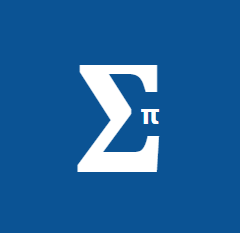Fundamentals of Informatics Practices (CLASS-XI and XII)
Learning Outcomes - At the end of this course, students will be able to :
⇒ Identify the components of computer system.
⇒ Create Python programs using different data types, lists and dictionaries.
⇒ Understand database concepts and Relational Database Management Systems.
⇒ Retrieve and manipulate data in RDBMS using Structured Query Language.
⇒ Identify the Emerging trends in the fields of Information Technology.
Here at Sigma-Pi Academy, Video recording of every class and pdf of class notes will be
provided. Regular tests will be taken and we would work on the weakpoint of the student. Doubt
clearing at the time when the student is unable to solve the problem. Full assistance in
homework, assignment, unit test and exam preparation of schools. All the doubts will be cleared
till the student is satisfied 100%.

Course content for Class XI :
-
1. Introduction to Computer System :
Evolution of computing devices, components of a computer system and their interconnections, Input/output devices. Computer Memory: Units of memory, types of memory – primary and secondary, data deletion, its recovery and related security concerns. Software: purpose and types – system and application software, generic and specific purpose software. -
2. Introduction to Python, Basics of Python programming, Python interpreter :
Interactive and script mode, the structure of a program, indentation, identifiers, keywords, constants, variables, types of operators, precedence of operators, data types, mutable and immutable data types, statements, expressions, evaluation and comments, input and output statements, data type conversion, debugging. Control Statements: if-else, for loop Lists: list operations - creating, initializing, traversing and manipulating lists, list methods and built-in functions. Dictionary: concept of key-value pair, creating, initializing, traversing, updating and deleting elements, dictionary methods and built-in functions. -
3. Database concepts and the Structured Query Language Database Concepts :
a. Introduction to database concepts and its need, Database Management System.
b. Relational data model: Concept of domain, tuple, relation, candidate key, primary key, alternate key Advantages of using Structured Query Language, Data Definition Language, Data Query Language and Data Manipulation Language, Introduction to MySQL, creating a database using MySQL, Data Types Data Definition: CREATE TABLE Data Query: SELECT, FROM, WHERE. Data Manipulation: INSERT -
4. Introduction to the Emerging Trends :
Artificial Intelligence, Machine Learning, Natural Language Processing, Immersive experience (AR, VR), Robotics, Big data and its characteristics, Internet of Things (IoT), Sensors, Smart cities, Cloud Computing and Cloud Services (SaaS, IaaS, PaaS); Grid Computing, Block chain technology. -
5. Revision and Mock test.
Course content for Class XII :
-
1. Introduction to Python libraries :
Pandas, Matplotlib. Data structures in Pandas - Series and Data Frames. Series: Creation of Series from – ndarray, dictionary, scalar value; mathematical operations; Head and Tail functions; Selection, Indexing and Slicing. Data Frames: creation - from dictionary of Series, list of dictionaries, Text/CSV files; display; iteration; Operations on rows and columns: add, select, delete, rename; Head and Tail functions; Indexing using Labels, Boolean Indexing; Importing/Exporting Data between CSV files and Data Frames. Data Visualization Purpose of plotting; drawing and saving following types of plots using Matplotlib – line plot, bar graph, histogram Customizing plots: adding label, title, and legend in plots. -
2. Database Query using SQL Math functions :
POWER (), ROUND (), MOD (). Text functions: UCASE ()/UPPER (), LCASE ()/LOWER (), MID ()/SUBSTRING ()/SUBSTR (), LENGTH (), LEFT (), RIGHT (), INSTR (), LTRIM (), RTRIM (), TRIM (). Date Functions: NOW (), DATE (), MONTH (), MONTHNAME (), YEAR (), DAY (), DAYNAME (). Aggregate Functions: MAX (), MIN (), AVG (), SUM (), COUNT (); using COUNT (*). Querying and manipulating data using Group by, Having, Order by. -
3. Introduction to Computer Networks :
Introduction to networks, Types of network: LAN, MAN, WAN. Network Devices: modem, hub, switch, repeater, router, gateway Network Topologies: Star, Bus, Tree, Mesh. Introduction to Internet, URL, WWW, and its applications- Web, email, Chat, VoIP. Website: Introduction, difference between a website and webpage, static vs dynamic web page, web server and hosting of a website. Web Browsers: Introduction, commonly used browsers, browser settings, add-ons and plug-ins, cookies. -
4. Societal Impacts, Digital footprint, net and communication etiquettes :
Data protection, intellectual property rights (IPR), plagiarism, licensing and copyright, free and opensource software (FOSS), cybercrime and cyber laws, hacking, phishing, cyber bullying, overview of Indian IT Act. E-waste: hazards and management. Awareness about health concerns related to the usage of technology. -
5. Project Work :
The aim of the class project is to create tangible and useful IT application. The learner may identify a real-world problem by exploring the environment. e.g., Students can visit shops/business places, communities or other organizations in their localities and enquire about functioning of the organization, and how data are generated, stored, and managed. The learner can take data stored in csv or database file and analyze using Python libraries and generate appropriate charts to visualize. If an organization is maintaining data offline, then the learner should create a database using MySQL and store the data in tables. Data can be imported in Pandas for analysis and visualization. Learners can use Python libraries of their choice to develop software for their school or any other social good. Learners should be sensitized to avoid plagiarism and violation of copyright issues while working on projects. Teachers should take necessary measures for this. Any resources (data, image etc.) used in the project must be suitably referenced. The project can be done individually or in groups of 2 to 3 students. The project should be started by students at least 6 months before the submission deadline. -
6. Discussing 3 papers x (3 Sets) = 9 papers.
-
7. Mock tests (5)
